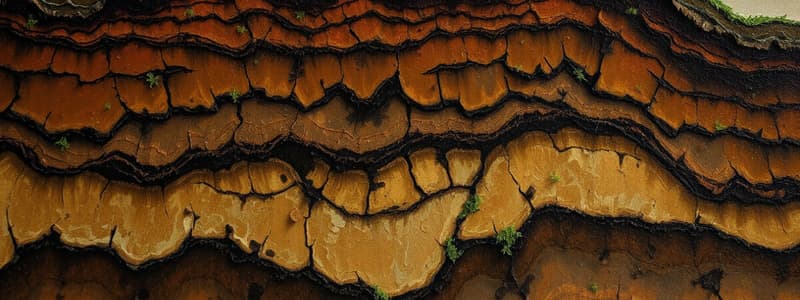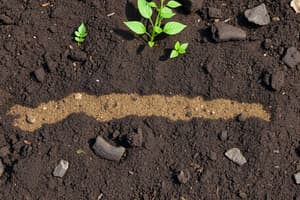Podcast
Questions and Answers
How do residual soil and transported soil differ?
How do residual soil and transported soil differ?
Residual soil stays over its parent rock. Transported soil forms from particles from another place.
How does dense plant growth affect the soil in tropical climates?
How does dense plant growth affect the soil in tropical climates?
Dense plant life provides a continuous supply of organic material.
Which kind of soils would you expect to find in the Gulf Coast states, which generally receive more than 65 cm of rain per year?
Which kind of soils would you expect to find in the Gulf Coast states, which generally receive more than 65 cm of rain per year?
pedalfer
How is tropical soil different from temperate soil?
How is tropical soil different from temperate soil?
What is a horizon?
What is a horizon?
What is humus?
What is humus?
What is soil?
What is soil?
What is a soil profile?
What is a soil profile?
List the three main layers in mature residual soils.
List the three main layers in mature residual soils.
How does weathering help form soil?
How does weathering help form soil?
How does the composition of the parent rock affect soil composition?
How does the composition of the parent rock affect soil composition?
Which climate would likely be best for growing crops with deep roots?
Which climate would likely be best for growing crops with deep roots?
Flashcards are hidden until you start studying
Study Notes
Soil Types and Formation
- Residual soil forms directly over its parent rock, while transported soil originates from particles that have been moved from a different location.
- Weathering, the breakdown of rock, plays a crucial role in soil formation by creating fine particles that contribute to the soil mixture.
Soil Characteristics in Climates
- Tropical climates with dense plant growth supply a continuous flow of organic material, enriching the soil.
- Gulf Coast states, receiving over 65 cm of rain annually, are characterized by pedalfer soils, which are rich in iron and aluminum oxides.
Comparison of Soil Horizons
- Tropical soil features a significantly thinner A horizon (topsoil) compared to temperate soil, affecting nutrient availability.
- Soil profiles display vertical sections that illustrate distinct layers, known as horizons, which include the A horizon, B horizon (subsoil), and C horizon.
Soil Components and Structure
- Humus, a dark organic material, comprises decomposed plant and animal matter, enhancing soil fertility.
- Soil itself is defined as a loose mixture of rock fragments and organic matter capable of supporting plant life.
Agricultural Considerations
- Deep-rooted crops thrive best in temperate climates, where thicker topsoil provides adequate support for extensive root systems.
- The composition of residual soils directly reflects the materials derived from the underlying parent rock, influencing soil texture and nutrient content.
Studying That Suits You
Use AI to generate personalized quizzes and flashcards to suit your learning preferences.




